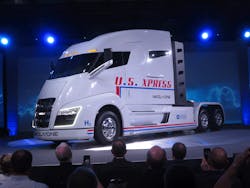Battery Could Double Mileage, Reduce Weight: Nikola
Nikola Corp. touted a new battery that it said has a “record energy density of 1,100 watt-hours per kilogram on the material level and 500 watt-hours per kilogram on the production cell level.” The prototype cell removes binder material and current collectors, enabling more energy storage, the company said in a press release announcing the development.
According to Nikola, the technology could increase the range of current EV passenger cars from 300 miles up to 600 miles with little or no increase to battery size and weight, and allow a truck to travel 1,000 miles between stops.
“This is the biggest advancement we have seen in the battery world,” said Trevor Milton, CEO of Nikola Motor Co., in a prepared statement. “We are not talking about small improvements; we are talking about doubling your cell phone battery capacity. We are talking about doubling the range of BEVs and hydrogen-electric vehicles around the world.
“Nikola is in discussions with customers for truck orders that could fill production slots for more than 10 years and propel Nikola to become the top truck manufacturer in the world in terms of revenue. Now the question is why not share it with the world?”
Nikola said it would share the intellectual property with other OEMs, even competitors, that contribute to the Nikola IP license and new consortium.
Nikola said it has entered into a letter of intent to acquire a world-class battery engineering team to help bring the new battery to pre-production. Through this acquisition, Nikola will add 15 PhDs and five master’s degree team members.
Nikola battery potential
- Battery electric trucks could now drive 800 miles fully loaded between charges
- Nikola trucks could weigh 5,000 lbs. less than the competition if same battery size was kept
- Nikola’s hydrogen-electric fuel cell trucks could surpass 1,000 miles between stops and top off in 15 minutes
- World’s first free-standing electrode automotive battery
- Energy density up to 1,100 watt-hours per kg on a material level and 500 watt-hours per kg on a production cell level including casing, terminals and separator -- more than double current lithium-ion battery cells
- Cycled over 2,000 times with acceptable end-of-life performance
- 40 percent reduction in weight compared to lithium-ion cells
- 50 percent material cost reduction per kWh compared to lithium-ion batteries
Source: Nikola Corp.
